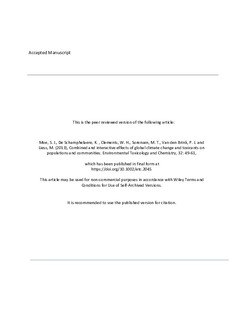Combined and interactive effects of global climate change and toxicants on populations and communities
| dc.contributor.author | Moe, S. Jannicke | |
| dc.contributor.author | De Schamphelaere, Karel | |
| dc.contributor.author | Clements, William H. | |
| dc.contributor.author | Sorensen, May T. | |
| dc.contributor.author | Van den Brink, Paul J. | |
| dc.contributor.author | Liess, Matthias | |
| dc.date.accessioned | 2018-11-13T08:27:06Z | |
| dc.date.available | 2018-11-13T08:27:06Z | |
| dc.date.created | 2013-06-14T21:30:46Z | |
| dc.date.issued | 2013 | |
| dc.identifier.citation | Environmental Toxicology and Chemistry. 2013, 32 (1), 49-61. | nb_NO |
| dc.identifier.issn | 0730-7268 | |
| dc.identifier.uri | http://hdl.handle.net/11250/2572090 | |
| dc.description.abstract | Increased temperature and other environmental effects of global climate change (GCC) have documented impacts on many species (e.g., polar bears, amphibians, coral reefs) as well as on ecosystem processes and species interactions (e.g., the timing of predator–prey interactions). A challenge for ecotoxicologists is to predict how joint effects of climatic stress and toxicants measured at the individual level (e.g., reduced survival and reproduction) will be manifested at the population level (e.g., population growth rate, extinction risk) and community level (e.g., species richness, food‐web structure). The authors discuss how population‐ and community‐level responses to toxicants under GCC are likely to be influenced by various ecological mechanisms. Stress due to GCC may reduce the potential for resistance to and recovery from toxicant exposure. Long‐term toxicant exposure can result in acquired tolerance to this stressor at the population or community level, but an associated cost of tolerance may be the reduced potential for tolerance to subsequent climatic stress (or vice versa). Moreover, GCC can induce large‐scale shifts in community composition, which may affect the vulnerability of communities to other stressors. Ecological modeling based on species traits (representing life‐history traits, population vulnerability, sensitivity to toxicants, and sensitivity to climate change) can be a promising approach for predicting combined impacts of GCC and toxicants on populations and communities. | nb_NO |
| dc.language.iso | eng | nb_NO |
| dc.publisher | Wiley | nb_NO |
| dc.relation.uri | http://onlinelibrary.wiley.com/doi/10.1002/etc.2045/pdf | |
| dc.title | Combined and interactive effects of global climate change and toxicants on populations and communities | nb_NO |
| dc.title.alternative | Combined and interactive effects of global climate change and toxicants on populations and communities | nb_NO |
| dc.type | Journal article | nb_NO |
| dc.type | Peer reviewed | nb_NO |
| dc.description.version | acceptedVersion | nb_NO |
| dc.source.pagenumber | 49-61 | nb_NO |
| dc.source.volume | 32 | nb_NO |
| dc.source.journal | Environmental Toxicology and Chemistry | nb_NO |
| dc.source.issue | 1 | nb_NO |
| dc.identifier.doi | 10.1002/etc.2045 | |
| dc.identifier.cristin | 1034363 | |
| cristin.unitcode | 7464,30,23,0 | |
| cristin.unitname | Nedbørfeltprosesser | |
| cristin.ispublished | true | |
| cristin.fulltext | original | |
| cristin.fulltext | postprint | |
| cristin.qualitycode | 2 |
Tilhørende fil(er)
Denne innførselen finnes i følgende samling(er)
-
Publikasjoner fra Cristin - NIVA [2160]
-
Scientific publications [1172]
